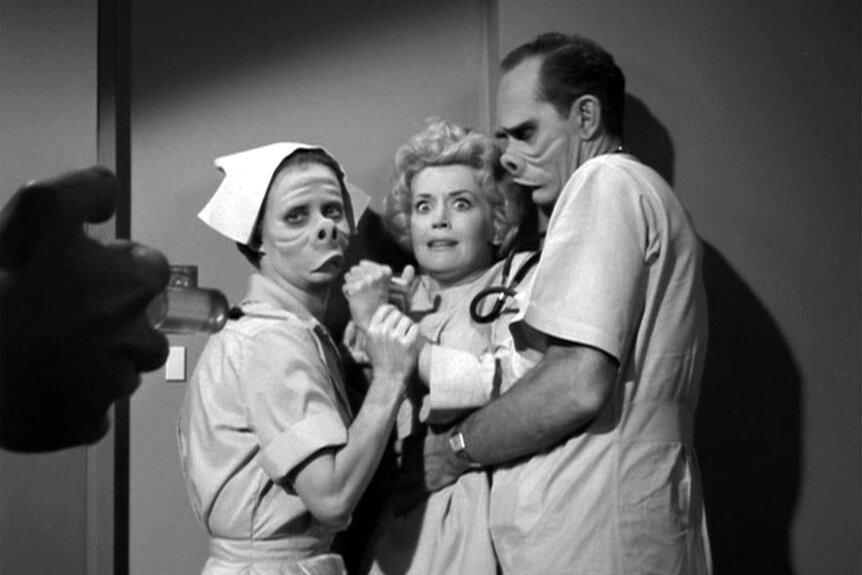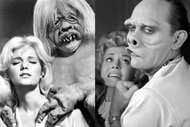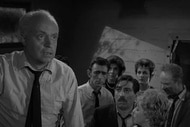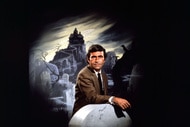Create a free profile to get unlimited access to exclusive videos, sweepstakes, and more!
Why The Twilight Zone Endures After All These Years
The Twilight Zone first aired in 1959, but it still feels relevant today.

It’s been more than 60 years since Rod Serling first showed up in black-and-white on television screens across the country and introduced us to “a series of imaginative tales that are not bound by time or space or the established laws of nature.”
The show Serling was hosting, of course, was The Twilight Zone. The original anthology series ran for five seasons, aired 156 episodes, and changed the face of sci-fi forever. In the decades since, you can see The Twilight Zone’s influence everywhere, from Simpsons spoofs to the work of filmmakers like M. Night Shyamalan and J.J. Abrams. It also spawned a feature film as well as two TV reboots, the most recent one a reimagining of the series by Jordan Peele.
RELATED: How to Watch SYFY's Super-Sized Twilight Zone New Year's 2023 Marathon To Ring In 2024
The series continues to impact us to this day, and will once again have a mega-marathon on SYFY over New Year’s Eve. Here are some reasons why Serling’s show remains an integral part of our culture after all these years.
The Tragic Twists
Most of the best-known Twilight Zone episodes have a mind-warping twist at the end that leaves an indelible mark on those who watch them. Those twists burrow into your brain and make you question your perceptions or assumptions of others and the world around you. Whether it's contemplating the subjectivity of beauty, such as in “Eye of the Beholder,” or questioning what it means to be alien in “The Invaders,” many of The Twilight Zone stories will leave you slack-jawed or gasping as you take in the final reveal.
The Stories Explore the Human Condition
Not all Twilight Zone stories end with a twist, however, and while they almost always have a sci-fi or supernatural bent to them, the episodes (like many genre works) are rooted in themes about the human condition — the fears and desires that are buried deep into our lizard brains that will likely haunt us to the end of time.
More than a few episodes, such as “Five Characters in Search of an Exit,” have a claustrophobic edge to them that will make your heart beat all the faster. Other episodes are also Faustian in nature, with the characters making decisions that may look good in the short-term but come back to bite them in the end (sometimes literally, as in the episode, “To Serve Man”). No matter what theme drives each story, however, they all have one thing in common: The themes and issues are as relevant today as they were back in the ‘50s and ‘60s.
We Get Glimpses of Many Actors Before They Hit It Big
The Twilight Zone is an anthology series and as such, had a large cast. Some of the actors like Buster Keaton (“One Upon a Time”) and Mickey Rooney (“The Last Night of a Jockey”) were well known at the time. Many others, however, were relative unknowns whose careers grew after their Twilight Zone appearance.
Before William Shatner became Captain James T. Kirk, he was on two episodes of The Twilight Zone — “Nick of Time” and the well-known “Nightmare at 20,000 Feet,” where Shatner sees more than he bargained for on the wing of the plane he’s flying in. Another Star Trek actor, George Takei, also stars in an episode called “The Encounter” and Spock himself, Leonard Nimoy, is in “A Quality of Mercy.”
RELATED: George R.R. Martin on Why He Owes His TV Career to The Twilight Zone
Other notable actors you’ll see on the original series include Charles Bronson (“Two”), Robert Duvall (“Miniature”), Robert Redford (“Nothing in the Dark”), Dennis Hopper (“He’s Alive”), Burt Reynolds (“The Bard”), and Carol Burnett (“Cavender is Coming”).
You can see all these actors in the early days of their careers on the series, which just adds gravy to the already rich meal found in each episode.
The Twilight Zone marathon begins on the SYFY channel on Saturday, December 30 at 8 a.m. EST and runs through Tuesday, Jan. 2 at 1 a.m. You can check out the full schedule here.
Originally published Dec 28, 2022.




























